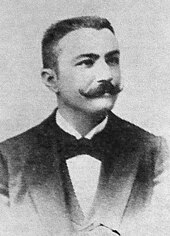
Baron Adrien Victor Joseph de Gerlache de Gomery was a Belgian officer in the Belgian Royal Navy who led the Belgian Antarctic Expedition of 1897–99.

The Belgian Antarctic Expedition of 1897–1899 was the first expedition to winter in the Antarctic region. Led by Adrien de Gerlache de Gomery aboard the RV Belgica, it was the first Belgian Antarctic expedition and is considered the first expedition of the Heroic Age of Antarctic Exploration. Among its members were Frederick Cook and Roald Amundsen, explorers who would later attempt the respective conquests of the North and South Poles.

Gerlache Strait or de Gerlache Strait or Détroit de la Belgica is a channel/strait separating the Palmer Archipelago from the Antarctic Peninsula. The Belgian Antarctic Expedition, under Lt. Adrien de Gerlache, explored the strait in January and February 1898, naming it for the expedition ship Belgica. The name was later changed to honor the commander himself.

Henryk Arctowski Polish Antarctic Station is a Polish research station on King George Island, off the coast of Antarctica.

Bears' Cave is located in the western Apuseni Mountains, on the outskirts of Chișcău village, Bihor County, northwestern Romania. It was discovered in 1975 by Speodava, an amateur spelaeologist group.

The Law-Racoviță-Negoiță Station, known only as the Law-Racoviță Station until 2011, is the first Romanian station for research and exploration in Antarctica, named after the Romanian explorer Emil Racoviță and inaugurated on January 13, 2006 at the location of a station constructed in 1986 by Australia and donated to Romania. The station may be found in Princess Elizabeth Land, in the Larsemann Hills, 2 kilometres (1.2 mi) away from China's Antarctic Zhongshan Station.

Scărișoara Cave, is one of the biggest ice caves in the Apuseni Mountains of Romania, in the western part of the Romanian Carpathians. It is considered a show cave and one of the natural wonders of Romania. It has also been described as a glacier cave.
Iuliu Hațieganu University of Medicine and Pharmacy in Cluj-Napoca, Romania, is the oldest medical education institution in Transylvania, a continuation of the Faculty of Medicine which was founded in 1919, as a part of the Superior Dacia University. The university has over 6,000 national and international students, 2,400 resident physicians, as well as over 1,100 teachers and researchers. It was named in honor of the scientist Iuliu Hațieganu. The university is classified as an "advanced research and education university" by the Ministry of Education.

Belgica antarctica, the Antarctic midge, is a species of flightless midge, endemic to the continent of Antarctica. At 2–6 mm (0.08–0.2 in) long, it is the largest purely terrestrial animal native to the continent. It also has the smallest known insect genome as of 2014, with only 99 million base pairs of nucleotides and about 13500 genes. It is the only insect that can survive year-round in Antarctica.
Teodor Gheorghe Negoiță was a polar region explorer. In 1995 he became the first known Romanian explorer to reach the North Pole.

Antoni Bolesław Dobrowolski was a Polish geophysicist, meteorologist and explorer.

Belgica was a barque-rigged steamship that was built in 1884 by Christian Brinch Jørgensen at Svelvik, Norway as the whaler Patria. In 1896, she was purchased by Adrien de Gerlache for conversion to a research ship, taking part in the Belgian Antarctic Expedition of 1897–1901, becoming the first ship to overwinter in the Antarctic. In 1902, she was sold to Philippe, Duke of Orléans and used on expeditions to the Arctic in 1905 and from 1907 to 1909.

The Ethnographic Museum of Transylvania is situated in Cluj-Napoca, Romania. With a history of almost 100 years, the Ethnographic Museum of Transylvania is one of the first and greatest of its kind in Romania. It has two exhibition sections, one of which is to be found in downtown Reduta Palace, while the other exhibition section is the open-air Romulus Vuia Park situated on the city's north-west side, in Hoia Forest.

Georges Lecointe was a Belgian naval officer and scientist. He was captain of the Belgica and second-in-command of the Belgian Antarctic Expedition, the first to overwinter in Antarctica. After his return to Belgium he was the founder of the International Polar Organization and deeply involved in the foundation of the International Research Council and the International Astronomical Union.

Marcian David (Matty) Bleahu was a Romanian geologist, speleologist, geographer, alpinist, explorer, writer and politician. He is well known for his scientific contributions to the development of the theories of global tectonics, for his pioneering in speleology and for the development of this science, but also for the popularization of science and of ecology in Romania.

Biospeleology, also known as cave biology, is a branch of biology dedicated to the study of organisms that live in caves and are collectively referred to as troglofauna.

Hajongard cemetery, on Avram Iancu Street, is one of the oldest cemeteries in Cluj-Napoca, Romania, founded in the sixteenth century. It is one of the most picturesque sights of the city. It covers an area of approximately 14 hectares.
Cuciulat Cave is located on the Podișul Someșan plateau, near the village Cuciulat in the commune Letca, Sălaj County, Romania. It contains the oldest known cave paintings in Central Europe.
Florica Topârceanu is an Antarctic researcher, best known for her work was on Antarctic aquatic viruses and the development of the Antarctic scientific community in Romania. She was the first Romanian woman biologist to study life in Antarctica and the first Romanian woman expert to the Antarctic Treaty.



















